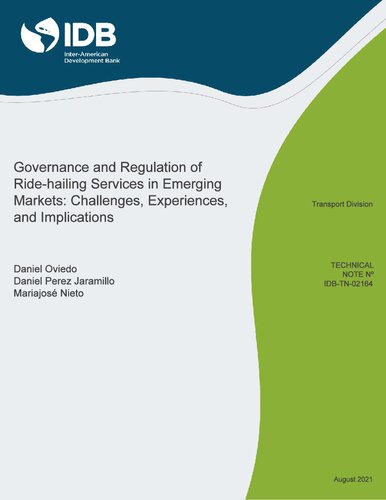Between 2010 and 2019, the e-hailing industry -understood as digitally enabled transport
services that connect spare capacity or idle goods with demand for mobility- has seen a total
disclosed investment of USD56.2 billion (Holland-Letz et al., 2019). Some forecasts suggest
an expected growth of 25% by 2025 (considering business areas such as bike-sharing,
ridesharing, car-sharing, and ride-hailing), with most investments concentrating on companies
originating in the United States, China, and Europe (Wolff, Possnig & Petersen, 2019). These
companies have rapidly expanded their operations to cities globally, including significant
investments in cities in the global south were also a fertile ecosystem for start-up investments.
Entrepreneurship has given rise to homegrown companies seeking to fill gaps in the urban
mobility market through data-driven innovations and adapted versions of services for the local
conditions (WEF, 2019).
These investments and growing interest from stakeholders at all levels ? investors, operators,
users, incumbents, and decision-makers ? make ride-hailing a topical concern that re-defines
urban mobility and what it may mean in the future. Moreover, the development, expansion,
and operation of urban mobility start-ups in the sharing economy suggest that emerging
innovations for urban mobility such as ride-hailing are here to stay in one form or another. The
process in emerging markets has outpaced decision-making and law-makers’ ability to
produce guidelines and regulations for the operation and control of ride-hailing. In Latin
America, apart from Mexico and Brazil, Ride-hailing has yet to be regulated on a national scale.
Currently, the window of opportunity to regulate Ride-hailing services shaping their evolution
instead of just responding to it is rapidly closing as new large-scale competitors such as DiDi
enter emerging markets, and new forms of app-based ride-hailing services emerge from local
and international players alike.
This paper seeks to shed some light on the different considerations for regulation and
governance of ride-hailing platforms in emerging markets, highlighting their positive and
negative externalities. Building on an extensive review of the literature and secondary sources,
we outline Ride-hailing’s identified and potential effects on users (providers and consumers),
incumbents, and society. Based on the welfare impact?s structure, we identify the significant
challenges that regulators face in understanding, monitoring, evaluating, and regulating this
type of transportation innovation. Finally, the paper proposes a framework for approaching
such mobility innovations from governance and regulation perspectives. In a context of
exponential growth in research and innovation in urban mobility in general and Ride-hailing, a
rigorous review of the literature and a critical framework for understanding governance and
regulation in such services in rapidly changing contexts is a timely contribution.
Keywords: Ride-hailing, Regulation, Governance, Latin America
Technical
{PDF} Governance and regulation of ride-hailing services in emerging markets: challenges, experiences and implications Daniel Oviedo, Daniel P?rez, Mariajos? Nieto
$19.99






Reviews
There are no reviews yet.